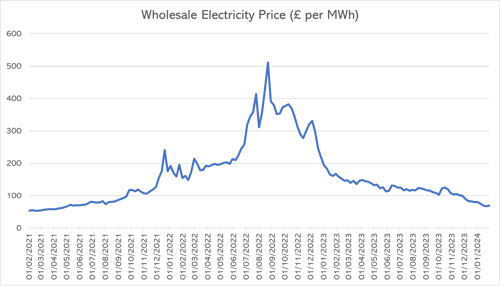
Our Energy Comparison Customers Say...
Why Energy Price Comparison Is Important
Wondering if switching energy suppliers is the right move now that the price cap level has been lowered? If you’re looking for some certainty around energy prices, you’re not alone.
A quick 30-second energy comparison is all it takes to ensure you're getting a great deal. What have you got to lose?
Check Live Rates
Why Look For Energy Quotes With Us?
We're proud to have our energy comparison service rated as Excellent based on over 4,000 reviews. We love helping our customers find great energy deals whether you’re looking for home or business energy.
It takes just 30 seconds to find live prices using our energy comparison engine; providing you with all the information allowing you to make an unbiased informed decision on who your new energy supplier should be.

HOW WE CAN HELP
How To Switch & Find Great Energy Deals
Simple energy rate comparison in just 30 seconds.
Find a new deal
Why Are Energy Prices So High?
Energy prices were affected by a range of external geopolitical events - such as the war in Ukraine - that saw wholesale prices rise steadily from 2021 and peak in late 2022. As a result energy prices that households and businesses paid were increased.

The result of this meant that Ofgem’s energy price cap increased to £3,549 in October 2022, and as a result, the government introduced the Energy Price Guarantee, limiting typical household usage to £2,500 per year.
Since then, the energy price cap has lowered to below the Energy Price Guarantee, so the Energy Price Guarantee is no longer used - except for pre-payment meters. Customers with pre-payment meters still have the benefit of the Energy Price Guarantee discount, to ensure they are not charged more than those who pay for their energy by direct debit.
You can read more in our History of the Energy Price Cap.
Are Energy Prices Coming Down?
Energy prices are well past the peak that we saw in 2022, and now we are seeing prices stabilise, and generally drop. But there is still a way to go before energy prices are lower than pre-energy crisis levels.
While household energy rates are still mostly in line with the energy price cap, the price cap has been trending downwards too. In January to March 2024, the price cap was set at £1,928 for a typical household and in April to June 2024, the price cap was set at £1,690, a £238 reduction.
Is It Time To Switch Energy Supplier?
Very few suppliers currently offer energy rates below the energy price cap, so if you compare energy rates, and find a deal that is lower than the price cap it may well be worth switching.
However, as the price cap has been trending downwards, you might find it beneficial to stick with your existing energy supplier for the time being.
It is worth noting though, that not all suppliers are equal, and a fixed contract brings with it predictability and consistency, and there is no threat of rising energy bills for a year or two.
What’s more, you may want to switch to a greener supplier or a supplier whose services are best suited to your home's needs.
Others may feel frustrated with the level of customer service that their current energy supplier offers, and if that's the case, then it’s worth switching even if your monthly energy cost remains the same.
What Can You Do About High Energy Prices?
If comparing energy prices and switching to a cheaper deal is not an option for you, there are still other things you can do to lower your home energy bills, such as:
- - Install smart meters to monitor the household’s energy usage
- - Use smart plugs to monitor appliances
- - Use a smart thermostat
- - Lower the temperature of your central heating
- - Wash clothes at a lower temperature
What Should I Consider When Choosing A Fixed Energy Deal?
There are a few things to consider when comparing energy deals, and looking to switch:
- Exit fees - if you regret your switch after the cooling-off period, there may be exit fees incurred when you switch again. Any new switch should take these fees into account to ensure switching still saves you money.
- Contract length - the price cap changes every three months, so when locking in a 12 or 24-month contract you run the risk of overpaying versus the price cap by the end of your contract. On the plus side, you are protected against unforeseen price cap rises.
- Compare the unit price per kWh - your energy quote may give you an annual cost or a direct debit cost, however, that is based on your previous usage and isn’t an indicator of future usage. Rather, compare unit prices to be sure the one you are switching to is cheaper than the energy price you are paying.
- Compare against the price cap unit rates - For January to March 2024, Ofgem's price cap is at 28.62p per kWh for electricity with a 53.3p daily standing charge, and 7.42p per kWh for gas, with a 29.6p per kWH daily standing charge. For April to June 2024, electricity is 24.5p per kWh and 60.10p daily standing charge and gas is 6.04p per kWh and a daily standing charge of 31.4p per day. More here.
How Do I Know If I’ve Found A Good Energy Deal?
Once you have your energy quotes, you’ll take aboard the considerations and if it means you’re paying less money than if you were to stick with the price cap, then you know you have a good deal.
What Details Do I Need to Switch?
All you need to switch energy suppliers is your address, including your postcode. From there our system can find your energy usage.
We’ll also need a name, phone number and email so that we can walk you through your switch.
Choosing The Right Tariff From Your Energy Comparison
If you’re looking to secure a cheap energy deal, selecting the right tariff type could help you reduce your costs. When you compare energy tariffs, it’s important to consider how and when you use your gas and electricity.
For example, if you use most of your energy at night, switching to a multi-rate tariff could help you save money. Below, you can find information on some of the most common types of gas and electricity tariffs.
Fixed Rate Tariff
Fixed rate tariffs lock in the price you pay per unit of energy (kWh) for a certain period of time, protecting you from wholesale energy price hikes. This offers you certainty and means you don’t have to worry about price increases during your contract.
Green Energy Tariff
Green energy tariffs have become increasingly popular as we put more focus on our environmental impact. Some suppliers will offer 100% renewable electricity, putting naturally sourced energy back into the grid. A renewable tariff may also include carbon-offsetting. This involves your supplier funding projects that help tackle carbon emissions to offset the gas customers use.
Economy 7 Tariff
An Economy 7 tariff aims to provide cheap energy deals by giving you cheaper energy rates for a seven-hour window during the night. The off-peak hours and the discount offered will vary from supplier to supplier. It’s worth bearing in mind that Economy 7 peak rates tend to be much higher than regular energy tariffs.
No Standing Charge Tariff
Your standing charge is a daily fee which covers the cost of maintaining your energy supply. A no standing charge tariff sets this daily fee to zero. This can be beneficial for properties where most of your energy is used seasonally or for only a few days a week. Unit rates on a no standing charge tariff can be higher than those on standard tariffs.
Variable Rate Tariff
Standard variable tariffs are also known as default tariffs and are often the deal your energy supplier puts you on if you haven’t specified your preferred energy deal. Your unit rate will vary depending on the current wholesale costs throughout the duration of your contract.
Prepayment Meter Tariff
Prepayment meters are installed in your home, allowing you to become a ‘pay as you go’ energy customer. Prepayment meters are powered by a ‘key’ or smart card that is topped up and inserted into the meter to power it. Whereas credit meters allow you to spread energy costs evenly over the year, prepayment meters require you to pay for your exact usage.
Dual Fuel Tariff
A dual fuel tariff means that you can purchase both your gas and electricity from the same supplier with the same energy tariff. Suppliers will often offer a discount for taking out a dual fuel tariff with them.
Dual fuel tariffs are only available to homeowners and are not offered on energy deals.
Feed-in Tariff
This type of energy deal is a product of the Feed-in Tariffs (FIT) government scheme designed to promote and encourage the implementation of renewable and low-carbon electricity generation technologies. A feed-in tariff is available for anyone who has installed their own method of renewable energy generation, such as solar panels.
Energy Comparison Support & Breaking Down Your Bill
Breaking down your energy bills to help you understand what drives the cost of your bills.
What Is Included In My Energy Bill?
Parliament UK has released information on what a typical energy bill consists of. The energy price cap in 2024 takes the following into account and is broken up as follows:
- Wholesale cost of energy - 49%
- Network maintenance costs - 21%
- Operating costs - 11%
- Policy costs/ levies - 9%
- VAT - 5%
- Supplier profit - 3%
- Other costs - 3%
Reducing Energy Costs
Whether you're looking to save money as a business or on home energy costs, becoming more efficient with gas and electricity is the key to cutting the price.
- Reducing the thermostat
- Switch off lights, computers and appliances when not in use
- Install energy-efficient lightbulbs
- Find a cheaper energy deal
- Draught-proof doors and windows
- Paperless policy
Energy Guides
You can find plenty of useful information in our handy energy guides.
No Standing Charge Tariffs Guide
In this guide, Energy Helpline will explain why energy suppliers add this fee to your bill and whether switching to a no-standing charge tariff could save you money.
How To Read Energy Meters
This guide helps you identify the different types of meters and how to read them.
The Difference Between Fixed and Variable Tariffs
There are some significant differences between fixed and variable tariffs. This guide will help you decide what the right one for you is.
DID YOU KNOW?
49% of consumers say they have never switched energy supplier, or have only switched once.† Make sure you're not missing out on better energy prices.
Don't overpay - compare energy prices today
Check Today's Rates
Energy Comparison & Switching FAQs
-
When Is The Best Time To Switch Energy Suppliers?
The best time to switch energy suppliers will depend on your individual circumstances. If you haven’t switched for a few years, you should compare energy prices to make sure you’re on the best deal available to you.
For those on a fixed term contract, the best time to switch will be when your renewal window opens and you have no exit fees to pay. If you allow your contract to expire, you’re likely to be placed on your supplier’s standard variable tariff. This tends to be one of the most expensive tariffs your supplier offers.
-
How Long Does It Take To Switch To A New Energy Deal?
The length of time it takes to switch can depend on whether you’re a business or domestic user, and on your tariff type.
Guidelines such as the Energy Switch Guarantee offer an agreement with suppliers to complete domestic and business energy switches within 5 working days. The process can take longer where extra work is required to complete your switch. This could include installing a new meter at your premises.
-
Will I Incur Exit Fees When Switching?
Most energy deals will include exit fees for ending your contract early before your renewal window. For business users, early cancellation fees can be significant.
However, you will not be charged an exit fee by your supplier if you switch during your renewal window. Your supplier should make you aware of when your renewal window and provide information on how your energy costs will change should you fail to switch.
-
What Is The Energy Switch Guarantee?
The Energy Switch Guarantee is a voluntary set of promises that suppliers can sign up to make sure switching energy is as simple as possible.
When signing up to the guarantee, suppliers agree to a number of promises and targets including:
- Completing a switch to a new tariff within 5 working days
- Your switch to a new tariff or supplier will be handled entirely by your new supplier
- If any problems occur with your switch, your new provider is responsible for contacting you and rectifying the issue swiftly
- If you change your mind within 14 days, you will simply remain on your old tariff with your original supplier
- You’ll review your bill from your original supplier no more than 6 weeks after the switch has been completed
- Any credit due to you will be refunded by your original supplier within 14 days of your final bill
-
Why Has My Energy Supplier Changed My Direct Debit?
Your monthly Direct Debit to your energy supplier is just a ‘estimate’ cost that’s suggested by your supplier to cover the monthly energy you’ve used - it’s never completely accurate.
At the end of winter, you might be in debit, which is the exact opposite of credit. Debit is incurred when your monthly Direct Debits aren’t enough to cover your usage. This is completely normal, and irons itself out when the warmer months come and you start using less energy.
-
How Will The Energy Price Guarantee Affect My Energy Bills?
the government have announced an Energy Price Guarantee which will see energy bills frozen at £2,500 (based on typical UK usage) from 1st October 2022 until 2024.
However, the price cap has been reduced below the guarantee. This means that the price cap is now active over the guarantee.
The energy price cap is a limit on how much your supplier can charge you for the gas and electricity you use on a default energy contract.
-
How Do I Get A Refund For Energy Over Payment?
In the vast majority of cases, all you need to do is ask. Industry regulator Ofgem has rules that force suppliers (including any of your previous ones) to refund you credit if you ask, unless they have very good reason not to.
-
Where Can I Find The Best Gas And Electric Deals?
Comparing multiple energy suppliers and tariffs is the best way to find competitive gas and electricity deals.
-
Is Energy Comparison Back?
In 2023, energy prices are much more stable and are up to 69% cheaper than October 2022. Now is a great time to switch domestic and business energy tariffs.














